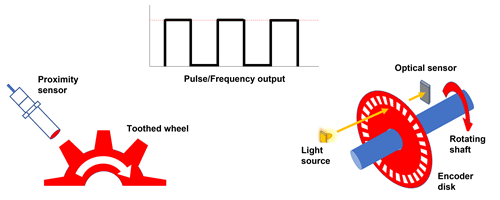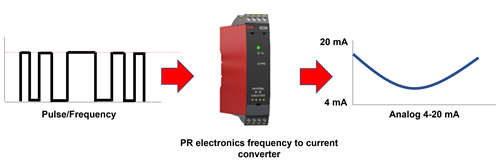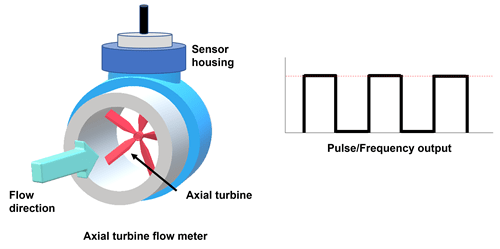
Frequency to analog converters are used to convert a pulse or frequency signal into a corresponding analog measurement signal in a control system.
Velocity and flow are the most common measurement signals. The safety and efficient product dosing of certain processes depend on accurate flow and velocity measurement.
Measure speed
In rotating machines, such as compressors and turbines, measuring and monitoring the rotational speed is necessary to prevent dangerous situations. Excessive rotational speed can lead to a catastrophe for personnel and equipment, if the rotational forces become greater than permitted by the material specifications.
Also in other applications, such as wind turbines, pumps, mixers, engines and machines, monitoring speed is an important factor to ensure a process runs smoothly and safely. Speed measurements are of vital importance for issues such as energy efficiency, productivity and the reliability and safety of equipment. Speed measurements are often done with sensors that generate a frequency or pulse signal, such as proximity switches, rotary and/or linear encoders and tachos.
The frequency or pulse output of these sensors is often converted back into a representative analog signal (e.g. 4-20mA or 0-10V) by a pulse/frequency to analog converter. This provides a universal measurement signal that can be read by a control system (such as a PLC or a frequency controller or a telemetry system).
Frequency to analog converters such as the PR 3225 / PR 4225 are suitable for converting the following signals:
- NAMUR
- NPN / PNP
- Tachograph
- S0 according to DIN 43864
- Potential-free contact
Measuring flow
Whether it is liquid, gas or steam; flow is measured and controlled in a great many industrial processes. Applications include the supply and discharge of (liquid) substances, aeration in waste water, gas supply for burners, steam control on boilers, natural gas distribution and many more areas where flow control is crucial for safety, load balancing and product delivery.
Depending on the application, a number of techniques are available for flow measurement, including differential pressure, Coriolis, ultrasonic, vortex and turbine measurement. 
Many of these types of flow meters have a pulse/frequency output that is representative of the flow rate being measured. An example is the turbine flow meter shown above which uses a magnetic pickup to measure the rotational speed of the turbine as the blades pass the sensor, and outputs a relevant pulse/frequency signal that is proportional to the flow rate.
Frequency to current conversion
The pulse or frequency outputs from the various sensors and transmitters used to measure velocity and flow are often converted to a current or voltage signal for interfacing with a control system.
Frequency to current converters or frequency to mA converters convert the relevant speed or current signal to a corresponding current signal, usually 4-20 mA. These devices often incorporate galvanic isolation to eliminate signal noise and transients often found in applications involving heavy motors and rotating machinery. Additional functionality is usually available in more advanced products as required by the application.
PR electronics offers a range of frequency to current converters with options for relay or NPN/PNP outputs in addition to (or simultaneously with) the analog outputs. Pulse division and multiplication options are also available to meet the interface challenges of existing and future applications.
Frequency to voltage conversion
Alternatively, frequency to voltage conversion can also be used where the signal is converted to a corresponding voltage, typically 2-10V depending on the interface requirements. The flexibility of the PR electronics range of devices allows conversion from frequency to current or frequency to voltage in the same device.
Frequency to frequency conversion
In some applications, a frequency signal must be adjusted to meet the requirements of the connected device. This may be due to transmission or response times, where frequency division or buffering may be required. A frequency output can also be used as a frequency or time base generator.
Advantages of PR electronics f/l & f/f converters
PR electronics offers products for frequency signal conditioning high technology, performance and flexibility. The extended frequency range, fast response time and high accuracy of PR electronics frequency to current converters make them an ideal choice for speed and flow monitoring applications.
Some of the available features include:
- Performance
- High galvanic isolation – up to 3.75 kVAC
- NE 21 – A-criterion EMC performance
- 18-bit signal dynamics
- Fast response times – up to < 30 ms
- Low energy consumption
- Can be used in low and high ambient temperatures
- High frequency measurement range – up to 100 kHz